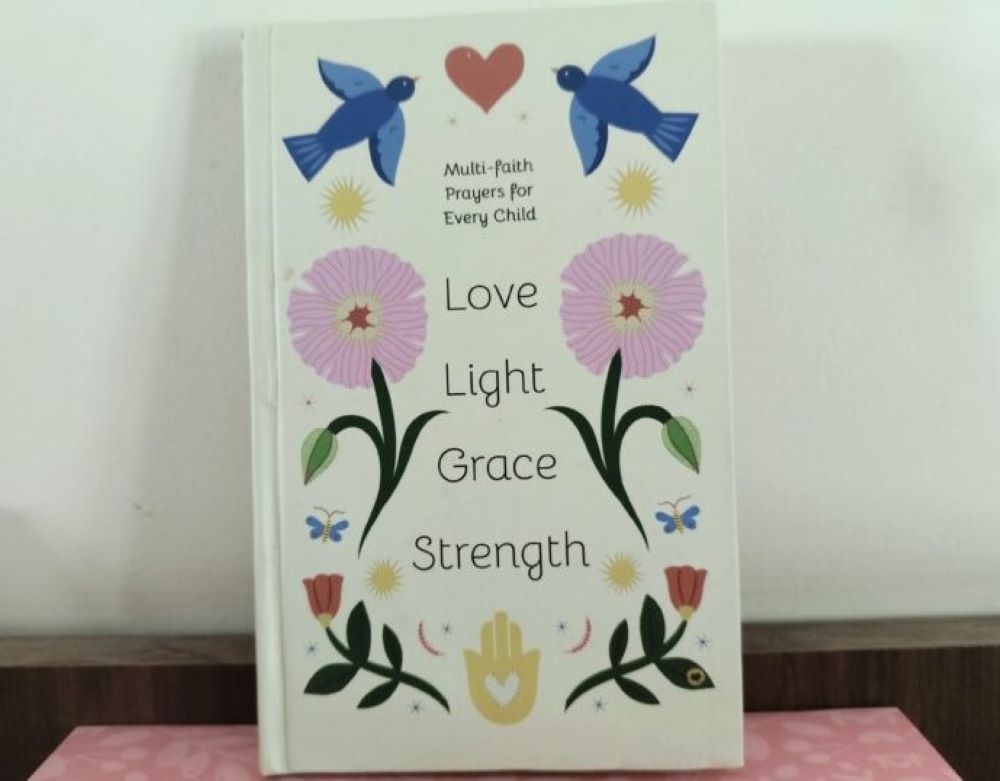Title: Love, Light, Grace, Strength: Multi-faith Prayers for Every Child
Illustrator: Maheswari Janarthanan
Cover Design: Maihtili Doshi Aphale
Type: Hardcover
Age group: 10 years+
Genre: Fiction/Poetry
Publisher: Talking Cub (An imprint of Speaking Tiger Books)
Length: 132 pages
Love, Light, Grace, Strength – Multi-Faith Prayers for Every Child
Before diving into the book review, I want to share a bit about my relationship with prayer, as it shaped how I felt about this book. Prayers have always been a part of my upbringing, but looking back, I realize that my understanding of prayer has evolved significantly.
As a child, prayer was a ritual. I would sit in the Pooja room, recite shlokas, and follow the practices simply because my parents told me to. It was more about tradition than personal connection.
In high school, prayer became a way of seeking help—whether for good grades or the courage to face challenges. It was transactional, centered around asking for something specific.
Then came a phase where prayer became a source of strength, a way to connect with something powerful beyond my understanding. It was no longer about asking for favours but about finding the courage to navigate tough times. Prayer became a comforting shoulder to lean on.
Now, prayer is about gratitude. It’s a moment of mindfulness, a way to express thankfulness for all that I have and even for what I don’t. It’s about seeking guidance, being present, and embracing life as it is.
With this evolving relationship with prayer, I was curious when I was asked to review Love, Light, Grace, Strength – Multi-Faith Prayers for Every Child. One look at the book, and I agreed immediately. I’ve always believed that the core of all faiths is unity, understanding, and connecting to a higher power—regardless of the name we use.
True faith, at its essence, promotes equality and respect for all beliefs. I was eager to see if this book captured that spirit through its multi-faith prayers. For me, it did deliver on that promise.
It beautifully showcased the universal values shared by different faiths. Divided into four sections—Light, Love, Grace, and Strength—this book captures the essence of the divine in various forms: as light, as nature, as the supreme power, and as love. It celebrates the beauty of nature, the strength found in surrender, love that transcends boundaries, and peace both within and beyond ourselves.
What makes this book truly special is its inclusivity. It draws from a wide range of faiths, including Hinduism, Islam, Christianity, Jainism, Buddhism, and more. It also features wisdom from philosophers and saints across different traditions, beautifully illustrating how love and integrity connect us all.
A particularly thoughtful touch is the inclusion of 2-3 blank pages at the end of each section, inviting readers to pen down their own thoughts and prayers. This makes the book not just a collection of prayers but also a personal journal of reflection.
Overall, I found this book to be a beautiful read. It’s one I can see myself reaching for on a dull day, opening to a random page, and finding words that resonate with me.
However, my 12-year-old daughter had a different take. She’s an avid reader who enjoys all genres, including poetry and philosophical books. She understands the concept of the divine both as deity forms and as light, so she didn’t struggle to grasp the verses. Yet, after reading the book in one go, she remarked that she wouldn’t pick it up again.
Intrigued, I asked her why. She explained that the verses and ideas felt repetitive to her. While I saw it as highlighting integrity in diversity, she felt it was just the same message expressed in different ways. It was interesting to see how differently we perceived the same thing.
She also mentioned that connecting to the divine as light or in other metaphysical forms felt a bit abstract for her. She preferred the Bhakti poetry she learned in her 7th-grade NCERT history textbook. That poetry also showcased people connecting with the divine across different faiths, but it did so through a more personal, relatable approach—depicting a direct relationship with God, almost like relating to another human being. She found that personification of the divine more approachable and easier to understand.
The upside to this difference in perspectives was that it sparked a meaningful conversation. It gave me the opportunity to address some of her thoughtful questions, like “Why should we learn about other faiths?” “Why is the divine often depicted as light in many prayers?” and “If all faiths talk about the same supreme power, why do we have so many different religions? What’s the need for them?”
Even though the book didn’t resonate with her as much, I realized that if it could ignite such deep questions and lead to a heart-to-heart discussion, it had served a valuable purpose.
The elegant cover illustration and the doodles on the inside pages by the illustrator Maheswari Janarthanan are pleasing to the eyes.
To sum up, this book was a delightful and inspiring read for me as an adult who enjoys philosophy, spirituality, and poetry. I do wish it had included the original verses with transliterations—it would have made the experience more wholesome.
Considering that the book is meant for children aged 10 and above, I feel it could have been more relatable with a bit more context and commentary. A storytelling approach woven around the verses would have made it less abstract and more approachable for young readers.
If this review resonated with you and you wish to buy the book from Amazon (kbc affiliate link),
CLICK & BUY NOW!Disclaimer: We got this book as part of #kbcReviewerSquad, and we feel happy and privileged to be part of it, as we are free to have our opinions and give an honest review of the book.






